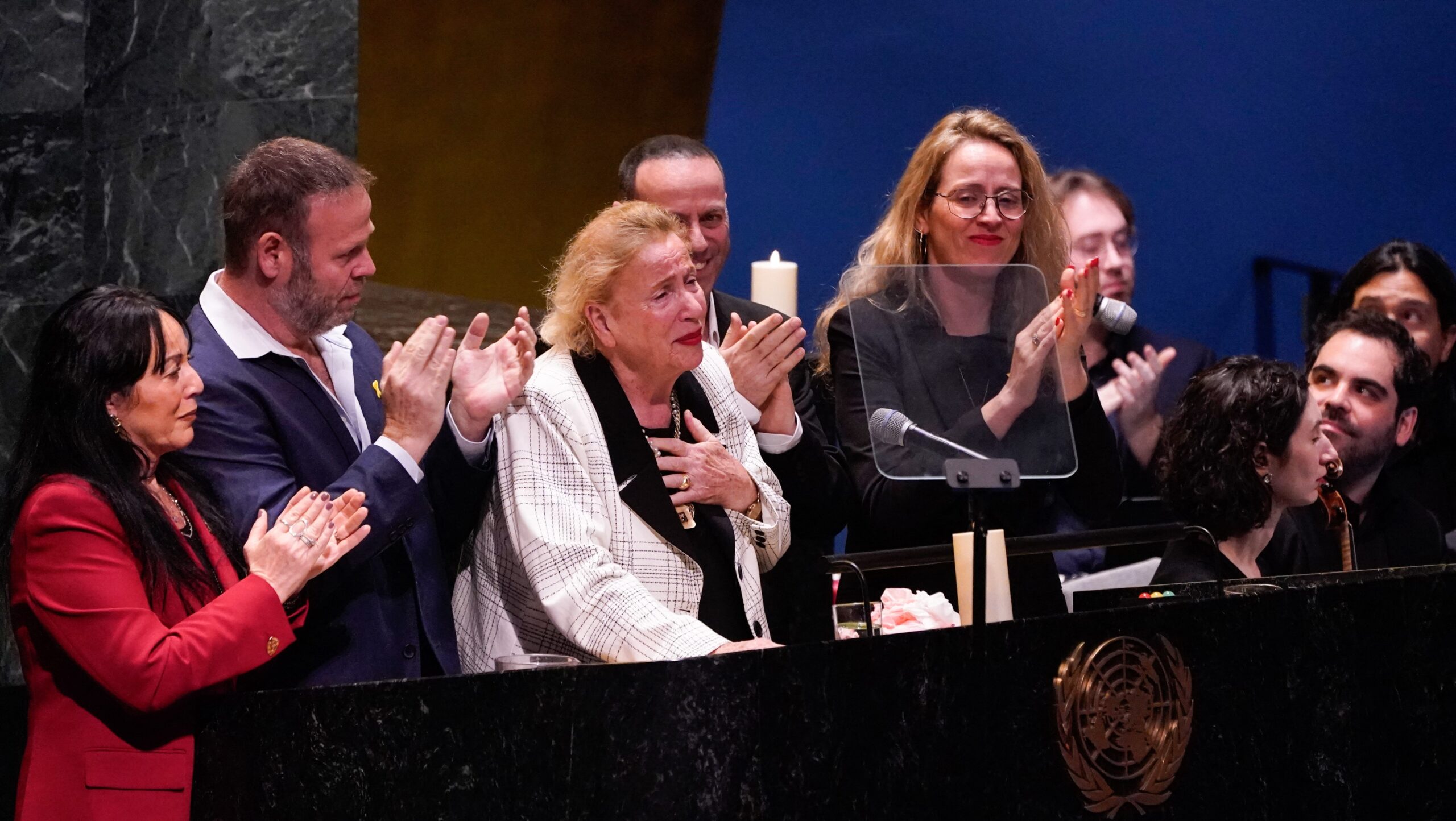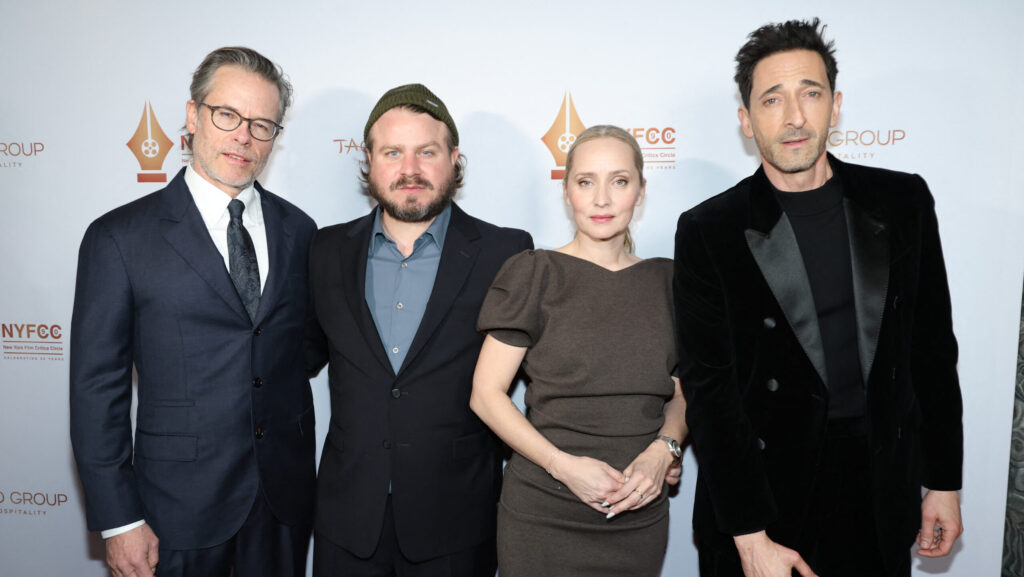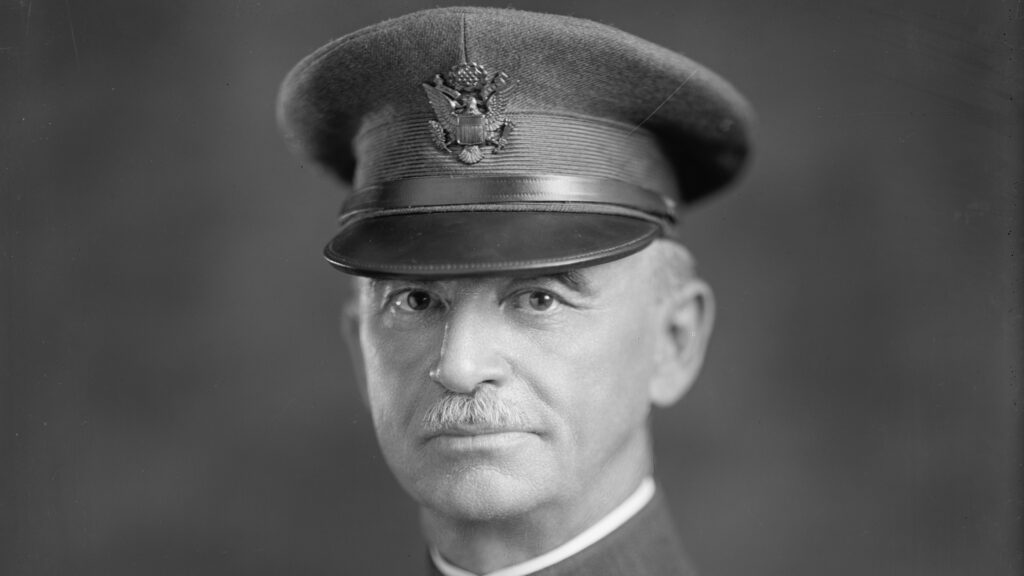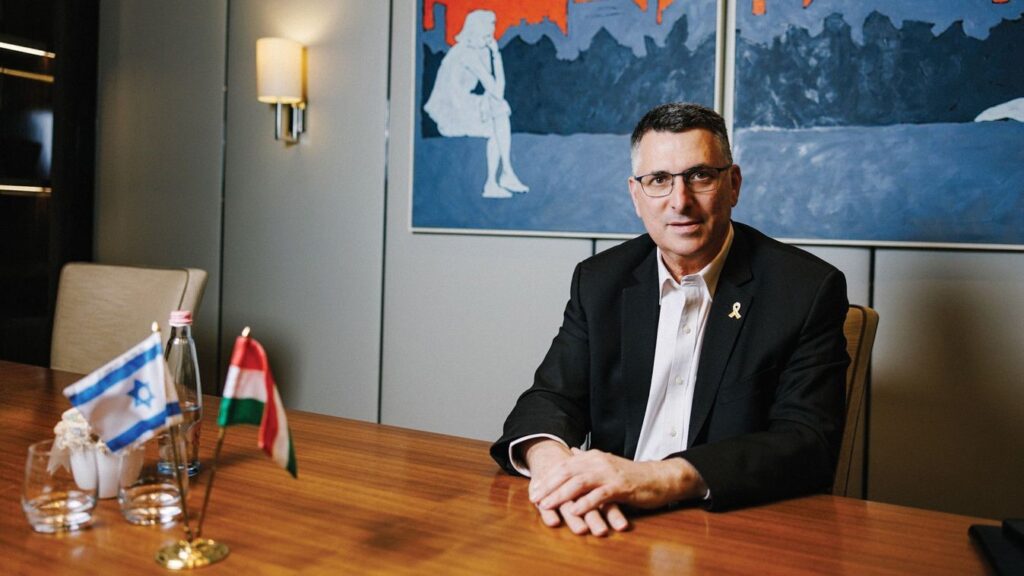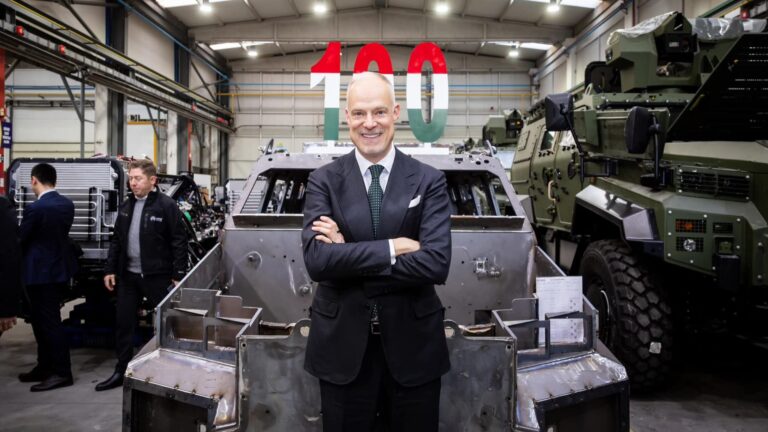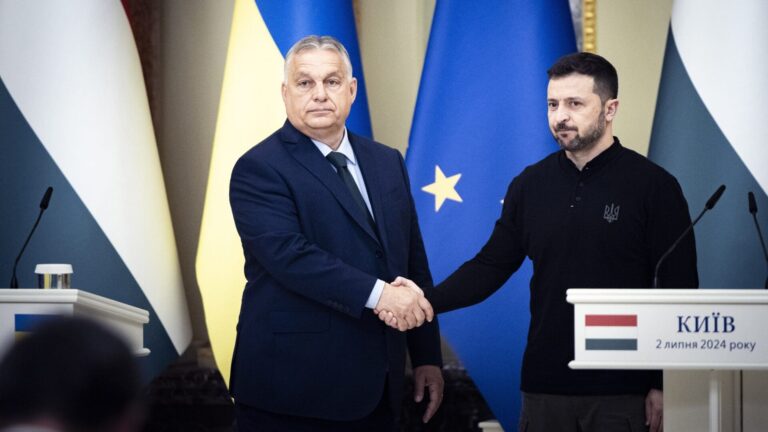A well-known Holocaust survivor and educator, Marianne Miller, born in Budapest, addressed the UN General Assembly on 27 January to mark the annual International Holocaust Remembrance Day and the 80th anniversary of the liberation of Auschwitz–Birkenau.
‘I represent today the 6 million Holocaust victims who were murdered just because they were Jewish. I demand the world remember what happened only 80 years ago,’ Miller said.
Miller was born in Budapest during World War II, where she endured the forced separation of her family and the murder of many of her close relatives. Since she survived, she later dedicated her life to educating future generations about the Holocaust, as well as to the dangers of hatred and intolerance.
Miller shared with everyone present the incredible story of her parents’ survival. Her parents, Alfred and Violetta Nobel, were a young couple deeply in love. Before her father was taken to a labour camp, her mother wanted to become pregnant; however, her father was against it. ‘You don’t bring a child into a world where sure death is waiting for them everywhere,’ he said. But her mother, so in love, replied: ‘Maybe one of us will stay alive, and they will have a memory of the other.’ ‘Under these conditions, I came into the world—a world where death awaited me at every corner.’
‘The Holocaust is a call to action for the protection of the people of Israel and the fight against antisemitism’
In 1944, on a freezing December night in Budapest, mothers were marching with their babies in deadly silence, heading toward the railway station; the destination was Auschwitz.
‘Then, something unprecedented happened. With a sudden movement, my mother tore off her yellow star and ran out of the line, holding me in her arms. She hid under a gate, thinking no one had seen her. But a young Hungarian Nazi chased after her, shouting and aiming his rifle at her chest. “How dare you take off the yellow star?” he roared. “Now I’m going to kill your child and make you watch. Then you’ll go back to the line without your baby,”’ Miller explained.
The holocaust survivor said there was no point at that moment to beg for mercy. All her mother had was a thin golden wedding ring which she held out to the Nazi soldier, saying: ‘Look! Look! You kill people and take their jewellery, but this ring is different—it is not covered in blood. It shines because you didn’t murder anyone for it. Take it. There is a blessing on it. You gave life to a mother and her child. Take it!’
Miraculously, as Miller phrased, ‘Maybe, in that one moment, he found a spark of humanity within himself. He didn’t follow her. He let her run, and we were saved.’
Her father’s story is no less remarkable. He was taken to the hunger camp of Bergen–Belsen, where he survived on one slice of bread per week. He had the willpower to divide it into seven pieces, eating one each day. At liberation, he weighed only 35 kilos—which is the weight of a child.
Miller expressed a desire to speak to world leaders at the United Nations during her participation in the 2024 International March of the Living, where thousands of participants take part in commemorative marches in both Budapest, Hungary, and Auschwitz–Birkenau, Poland. Revital Yakin-Krakovsky, deputy CEO of the International March of the Living, approached Danny Danon, Israeli ambassador to the United Nations, about Miller’s desire to speak at the world body, who said: ‘memory does not sustain itself; it needs to be protected, fought for and sustained so that even those who threaten it will not succeed in making it disappear. These pictures, testimonies and documents are for posterity so that when the voices of denial rise, the truth will stand as an unshakable beacon of justice.’
Danon added: ‘I would like to thank Marianne Miller and her family for being here and for their contribution to the preservation of memory and the fight for justice. The Holocaust is not just a historical memory—it is a call to action for the protection of the people of Israel and the fight against antisemitism. We will never forget.’
The Tragic Holocaust in Hungary
After Adolf Hitler rose to power in 1933, the Hungarian government became interested in forming an alliance with Nazi Germany. They believed that such an alliance would be beneficial, as both governments shared similar authoritarian ideologies. Additionally, they hoped that the Nazis could help Hungary recover territory lost during World War I. Over the next five years, Hungary moved increasingly closer to Germany.
The Munich Conference in September 1938 permitted Germany to annex the Sudeten region of Czechoslovakia. In November of the same year, Germany took a portion of Czechoslovakia that had previously belonged to Hungary and returned it to Hungary to strengthen the ties between the two nations. In August 1940, Germany granted Hungary control over northern Transylvania. By October 1940, Hungary had joined Germany, Italy, and Japan in the Axis alliance.
In March 1941 Hungary was awarded additional land after joining Germany in the invasion and division of Yugoslavia despite its alliance with the Yugoslav government. By this time, the Jewish population in Greater Hungary had grown to 725,007. This number does not include around 100,000 Jews who had converted to Christianity but were still racially considered to be ‘Jews’. Approximately half of Hungary’s Jewish population resided in Budapest, where they were well-acculturated and part of the middle class.
Hungary began implementing anti-Jewish legislation shortly after the Anschluss in March 1938. The government passed a law that reduced Jewish participation in the economy and various professions by 80 per cent. In May 1939 the Hungarian government further restricted Jews economically and classified them as a ‘racial’ group rather than a religious one. Additionally, in 1939, Hungary introduced a new type of labour service draft that required Jewish men of military age to enlist. Many Jewish men subsequently died due to the forced labour they were compelled to perform under this draft. In 1941 the Hungarian government enacted a racial law similar to the Nuremberg Laws, which officially defined who would be considered Jewish.
Although the anti-Jewish laws imposed many hardships, most Jews in Hungary lived in relative safety for much of the war. However, tragedy struck in the summer of 1941 when approximately 18,000 Jews, randomly designated by the Hungarian authorities as ‘Jewish foreign nationals’, were expelled from their homes and deported to Kamenets–Podolsk in Ukraine, where most were murdered. In early 1942 another 1,000 Jews in the territory of Hungary, newly acquired from Yugoslavia, were killed by Hungarian soldiers and police during their ‘pursuit of partisans’.
As the war progressed, the Hungarian authorities increasingly entrenched themselves in their alliance with Germany. In June 1941 Hungary decided to join Germany in its fight against the Soviet Union. By December 1941 Hungary had aligned itself with the Axis Powers by declaring war on the United States, effectively severing its ties with the West.
However, following Germany’s defeat at Stalingrad and other battles that resulted in the loss of tens of thousands of Hungarian soldiers, Regent Miklós Horthy began seeking a way to distance Hungary from its alliance with Germany. This move was unacceptable to Hitler. In March 1944 German troops invaded Hungary to force the country to remain loyal. Hitler quickly established a new government, believing it would be more compliant, appointing Döme Sztójay, Hungary’s former ambassador to Germany, as Prime Minister.
During the German occupation of Hungary, a Sonderkommando unit led by Adolf Eichmann was responsible for beginning the implementation of the ‘Final Solution’. The Nazis quickly enacted additional anti-Jewish decrees, establishing Judenräte (Jewish councils) across the country, with a central council known as the Zsidó Tanács created in Budapest under the leadership of Samu Stern.
To isolate the Jewish population from the outside world, the Nazis restricted their movement and confiscated their telephones and radios. Jewish communities were mandated to wear the Yellow Star, and Jewish properties and businesses were seized. Between mid to late April, Hungarian Jews were forced into ghettos, which existed for only a short time. After two to six weeks, the Jews from each ghetto were loaded onto trains and deported. Between May 15 and July 9, approximately 430,000 Hungarian Jews were deported, primarily to Auschwitz, where many were gassed upon arrival.
In early July Hungarian Regent Miklós Horthy halted the deportations as he sought to sever Hungary’s ties with Germany. By that point, almost all of Hungary was ‘Jew-free’, except for the capital city, Budapest. Throughout the spring of 1944, Israel Kastner, Joel Brand, and other members of the Budapest Relief and Rescue Committee began negotiations with the SS in hopes of saving lives. Additionally, many Jews—possibly up to 8,000—managed to flee Hungary, primarily to Romania, often with the assistance of members of Zionist youth movements.
From July to October 1944, the Jews of Budapest lived in relative safety. However, on October 15, Horthy publicly announced that he was ending Hungary’s alliance with Germany and seeking peace with the Allies. The Germans thwarted this move by toppling Horthy’s government and transferring power to Ferenc Szálasi and his fascist, violently antisemitic Arrow Cross Party. The Arrow Cross immediately initiated a reign of terror in Budapest. Nearly 80,000 Jews were killed in the city, shot on the banks of the Danube River and then thrown into the water. Thousands more were forced on death marches to the Austrian border. In December, during the Soviet siege of the city, 70,000 Jews were herded into a ghetto. Many died from cold, disease, and starvation.
During the Arrow Cross’s reign of terror, tens of thousands of Jews in Budapest were saved by members of the Relief and Rescue Committee and other Jewish activists, especially those from Zionist youth movements. They forged identity documents and provided food to those in need. These individuals worked in collaboration with foreign diplomats, such as Sweden’s Raoul Wallenberg and Switzerland’s Carl Lutz, who offered many Jews international protection.
Hungary was liberated by the Soviet army in April 1945. Tragically, up to 568,000 Hungarian Jews perished during the Holocaust.
King Charles III — First British Head of State to Visit Auschwitz
King Charles III stated that ‘the act of remembering the evils of the past remains a vital task’ during his meeting with Holocaust survivors in Poland. He spoke at a Jewish Community Centre in Krakow ahead of becoming the first British head of state to visit Auschwitz, where he attended a commemoration event marking the 80th anniversary of its liberation.
Meanwhile, the Prince and Princess of Wales met with survivors at a Holocaust Memorial Day ceremony in London, where William paid tribute to their ‘bravery’. Prime Minister Sir Keir Starmer also attended the event in London. Prince William expressed gratitude to those present for their ‘bravery in sharing the most harrowing moments of their lives’. He stated: ‘We remember the survivors who live with the scars, both mental and physical.’ Among the survivors who participated was Rachel Levy, who survived Auschwitz at the age of 13, along with Steven Frank and Yvonne Bernstein.
When asked about his ongoing efforts to share his experiences, Mr Frank stated: ‘I’ve had so much good fortune coming to this country. I’ve lived, loved, played sports, and built a wonderful family, so it’s time to give something back.’ Regarding a recent visit to Auschwitz, Sir Keir remarked: ‘It powerfully demonstrated how the Holocaust was a collective endeavour involving thousands of ordinary individuals who were utterly consumed by hatred for those who were different.’ He added: ‘That is the hatred we stand against today, and it is a collective endeavour for all of us to defeat it.’
People across the UK were invited to light candles in their windows to honour those who lost their lives and to stand against prejudice and hatred. As part of the ‘Light the Darkness’ national event, many landmarks, buildings, and monuments were illuminated in purple, including the London Eye and the Liver Building in Liverpool. A candle was also lit at No 10 Downing Street.
‘As the number of Holocaust survivors regrettably declines with the passage of time, the responsibility of remembrance rests on our shoulders’
Auschwitz–Birkenau was the largest Nazi concentration camp and played a central role in the Nazi campaign to exterminate Europe’s Jewish population. The King has long desired to attend the liberation ceremony at Auschwitz, not only due to the significance of this historical milestone but also to witness the testimonies of survivors in a place marked by immense suffering. During his trip, he delivered a speech at the Jewish Community Centre in Krakow, where he met Holocaust survivors. In his address, he stated: ‘As the number of Holocaust survivors regrettably declines with the passage of time, the responsibility of remembrance rests on our shoulders.’
He also expressed that in Krakow, ‘from the ashes of the Holocaust, the Jewish community has been reborn.’ Sources close to the King indicate that this visit is profoundly meaningful to him, with one aide describing it as a ‘deeply personal pilgrimage’.
In 1943 the King’s grandmother, Princess Alice of Greece, saved a Jewish family by hiding them in her home in Nazi-occupied Athens. The King said that this act of bravery had brought him and the Royal Family a great sense of pride.
Oldest Holocaust Survivor Hostage Remains in Captivity
At 86 years old, Shlomo Mantzur is the oldest hostage currently held by Hamas. He was abducted from his home on October 7 in front of his wife and taken to Gaza in his own car by Hamas terrorists.
Mantzur immigrated to Israel as a child with his family after surviving the Farhud massacre in Baghdad, Iraq, in 1941.
On the anniversary of 7 October, Mantzur’s kibbutz, Kissufim, held a ceremony to honour those who were killed or taken hostage. During the ceremony, the kibbutz members expressed a heartfelt sentiment, stating: ‘We are not speaking about him right now—we are speaking directly to him.’
At the time of his capture on 7 October, Mantzur weighed just over 120 pounds, raising significant concerns about his health while in captivity. Released hostages have reported the challenging conditions in Gaza, particularly the lack of food. This situation has understandably led many to question what his condition will be like upon his return to Israel.
In an interview with the Jewish News, Mantzur’s granddaughter, Noam Safir, said: ‘He is the glue of our family. We just want him home.’
Related articles:

